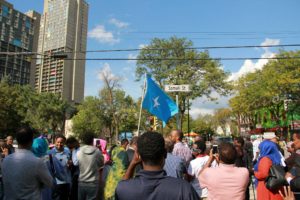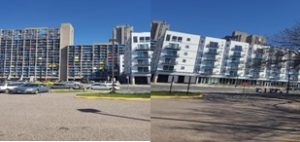By Faisal Roble
Following a successful Somali leadership summit hosted byTayo Consulting Group, I took time to walk through Cedar neighborhood in Minneapolis. Despite an uncharacteristically warm Sunday afternoon (April 22, 2017), the mood of the residents was subdued this time compared to three years ago when I last visited. Streets that would otherwise beam up with lively pedestrians, especially during beautiful spring weather, unnervingly looked eerie and deserted.

Cedar is home to the largest number of Somali businesses and immigrants that are seeking good life and safety in North America. Residents here thus far elected one state legislator (Ilhan Omar), a city council (Abdi Warsame), and played key role in putting US Congressman Keith Ellison into office. Mr. Ellison is the first Muslim elected to the US congress. Whether the dreams of Somalis in Cedar would be “deferred,” as Langston Hughes talked in a different context, by politics of hate is a subject of immense interest.
Cedar: Home away from Home
With former President Obama still in the White House three years ago (2014), I visited Cedar at the invitation of community leaders. I got the impressions that the area radiated hope and fortitude. Somalis showed tenacity not only to surmount challenges, but to also turn difficult obstacles into opportunities.
With their can-do attitude, family cohesion that extends to lineage, and strong faith in their religion, Somalis quickly and positively transformed Cedar; they turned around a rustbelt dilapidated business and old housing stock into a robust vibrant neighborhood. In time, they cleaned up and helped stabilize the real-estate market, and eventually took over a good percentage of the district’s storefront businesses.
Like other inner city neighborhoods, the little available reaction facilities are used to their full capacity. The community basketball court is always in use. Any outside visitor would not miss the overenthusiastic children with their Kofiya (Islamic hat) for boys and Xijab for girls swinging on the money bars. Serenity and peace was easily visible.
Outside development pressures had been weighing heavy on the community. The potential impacts of the expansion of the University of Minnesota, the coming of new light rail stations on the edge of Cedar, and a new stadium in the vicinity are forces of gentrification that loomed large for some time. Having conversation with the community on how to fend off these forces was the basis of my visit at the time.
One tool that I thought could help Somalis in their conversation with City Hall and developers was the establishment of Transit Oriented Developments (TODs) in their district. To do this would require that public input and community vision be integrated into the planning process early on. If done so, TODs could serve as focal points for economic growth and for accessing to jobs.
If not done in the past, Cedar leaders and its elected officials should certainly pursue this goal. One of the train stations that sits on the edge of Cedar is a major public works asset yet to be capitalized by the community.
There was tremendous willingness by the community to negotiate a meaningful public benefit package. On top of the list were jobs, affordable housing and better access to education, particularly giving Somali high school graduates access to neighboring University of Minnesota. So far, the verdict is out.

Meanwhile, some positive developments had already taken place in Cedar. In my walk-through, I could see tangible physical improvements. The 1,303 historic apartment complex known as Riverside Plaza, completed in 1974, has been recently refurbished colloquially knows as the “United Nations,” to denote the diversity of its occupants, this building has the highest concentration of Somalis anywhere in the world.
Additionally, in 2016, about 168 new affordable housing units have been built next to Riverside Plaza. The new 168 affordable units here account for 13% of the 1,300 affordable units the Twin cities built in 2015.
The renaissance of Cedar is a testimony for a new and futuristic Minneapolis where many races and people with different religious and ethnic backgrounds live side by side. Call it an urban rebirth phenomenon, this time Somalis are reviving an old American rustbelt urban neighborhood in Midwest America block by block. In the shifts that take place between Sunbelt and rustbelt, what Somali are doing to Cedar is a phenomenal America story with a Somali face.
Although the neighborhood could use some controls on amount of signage per business, new street light are installed to enhance pedestrian safety; sidewalks are repaired and repainted to enhance pedestrian experience.
By all accounts, the district signifies an indispensable new home for Somalis in North America. Although not entirely idyllic, it is a decent neighborhood and an urban Somali oasis. Cedar is home away from home worth the fight to protect and preserve.
Trump brings back Ugly Past
One hopes that the journey to achieving Cedar as the focal point for the dream of many Somalis remains undisrupted. However, a closer look at recent developments shows a community in siege. Thanks to a hatemongering and anti-immigrant obsession that President Trump harbors, Cedar is being lately obliterated by trigger-happy Immigration and Customs Enforcement (ICE).
An unprecedented intimidation against Somalis started with a speech President Trump gave on the outskirts of Minneapolis on November 7, 2017. It is understatement to say that Executive Order 13769 that banned seven largely-Muslim nations, including refugees from Somalia, fanned and perpetuated hate against Somalis.

Elected officials in Minnesota, including both Senators from the state, expressed their dismay about Trump’s bashing of Somalis. U.S. Rep. Keith Ellison, a Democrat from Minneapolis, said “the impact of Trump’s policies already are being felt.” I have talked to Somali families in Cedar and they expressed fear and terror since President Trump came to office.”
The combined weight of obtrusive FBI operations that started about a year ago and aggressive but largely illegal ICE operations had thrown an otherwise peaceful Somali community into a state siege. Jeff Sessions’ ascension to the office of Attorney General gave free rein to both agencies to unleash tactics of intimidation and harassment. Homes and work places are raided at will by ICE – a throwback to the 1980s when many cities in the United States declared themselves sanctuary cities to protect Central American refugees.
We are once again remained of the story covered by the 1980s movie called “El-Norte, depicting harrowing stories of Central Americans being raided and rounded up at work places – an instructive movie for getting in-touch with what is happening to Somali Minnesotans in 2017 and beyond.
Historically speaking, both the displacement of Somalis and their Central American predecessors have roots in past cold wars and supper power rivalry for dominance and control of strategic lands. Somalis are in America partly because US past US governments contributed to the destruction of Somalia.
Paul Manafort, one of Trump’s advisors who is under investigation for suspicion of dealings with Russia, has also represented in the 1980s the late President of Somalia, Mohamed Said Barre. Whatever services President Trump’s associate gave to Said Barre the, the destruction of Somalia started in the 1980s.
As I was leaving Minneapolis, I was informed that hundreds of former refugees, some with legal residences (Green Card holders), are detained at the Sherburne County jail located outside Minneapolis.
In a normal America with half-way decent leadership, most of the rounded up Somalis would be free and be with their families at home. But as America knows well, these are not normal times!
So far, with the exception of American-Arab Anti-Defamation Committee (AAADC), the country has been silent about the siege and intimidation suffered by Somalis in Cedar. The Black American Community is also absent from the scene.
It is doubly painful for such a thing to happen to an African-American community – Somalis – especially when Los Angeles and most of Black America is commemorating the 25th anniversary of the 1992 civil unrest because of a televised beating of Rodney King by LAPD.
The siege Cedar community is subjected to by ICE is another reminder of how America is still learning, refusing to learn in some contexts, to live comfortably with people of color.
ICE raids in Cedar is a reminder of Langston Hughes’ “What happens to a dream deferred?”
Does it dry up, like a raisin in the sun?
Or fester like a sore— and then run
Does it stink like rotten meat
Or crust and sugar over— like a syrupy sweet
Maybe it just sags, like a heavy load.
Or does it explode?
Faisal Roble
Email:[email protected]
—
Faisal Roble, a writer, political analyst and a former Editor-in-Chief of WardheerNews, is mainly interested in the Horn of Africa region. He is currently the Principal Planner for the City of Los Angeles in charge of Master Planning, Economic Development and Project Implementation Division.
We welcome the submission of all articles for possible publication on WardheerNews.com. WardheerNews will only consider articles sent exclusively. Please email your article today . Opinions expressed in this article are those of the author and do not necessarily reflect the views of WardheerNews.
WardheerNew’s tolerance platform is engaging with diversity of opinion, political ideology and self-expression. Tolerance is a necessary ingredient for creativity and civility.Tolerance fuels tenacity and audacity.
WardheerNews waxay tixgelin gaara siinaysaa maqaaladaha sida gaarka ah loogu soo diro ee aan lagu daabicin goobo kale. Maqaalkani wuxuu ka turjumayaa aragtida Qoraaga loomana fasiran karo tan WardheerNews.
Copyright © 2024 WardheerNews, All rights reserved


